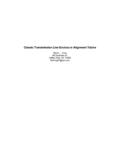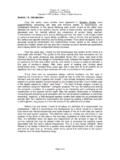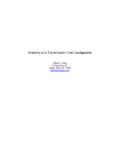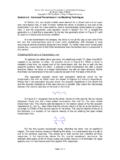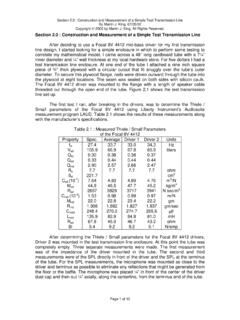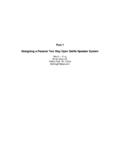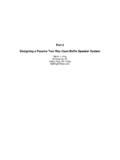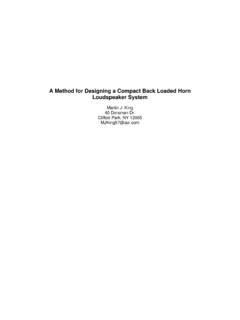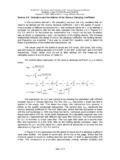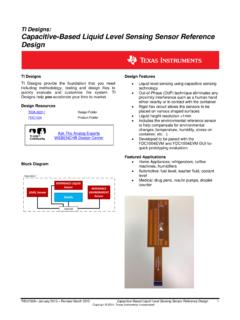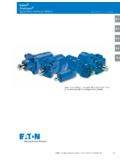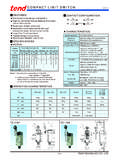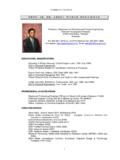Transcription of Jordan OB w Goldwood H Frame Speaker System
1 Jordan JX92S Open Baffle and Goldwood GW-1858 H Frame Two Way Speaker System Martin J. King 40 Dorsman Dr. Clifton Park, NY 12065 Jordan JX92S Open Baffle and Goldwood GW-1858 H Frame Two Way Speaker System By Martin J. King, 09/18/08 Copyright 2008 by Martin J. King. All Rights Reserved. Page 1 of 23 Introduction : My first open baffle design could only be described as huge. It not only filled the room with great sound, it physically filled the room with a solid wall of plywood when the baffle extending wings were rotated out to be flush with the front baffle. Once positioned in the room, these speakers were so heavy they never moved for almost three years while serving as my reference Speaker System . Moving them out of the way to try another set of speakers was out of the question. At some point this arrangement could not continue and this past August they were disassembled and replaced with a new dipole Speaker System .
2 Over the past couple of years, I have learned a lot more about dipole speakers. Typical of the way I work, my first open baffle Speaker design was a brute force approach where I threw baffle size at the problem with little thought for optimization of the baffle width and driver Qts to manage the bass extension. Recently, I have added an open baffle theory section to my web site which documents some of the lessons I have learned. The first article in this section describes the trade-offs used to design a fairly compact open baffle Speaker System using only passive crossovers. Shortly after the first article was completed, I added a second article focusing on extending the bass response of dipole speakers using appropriate driver selection and a U or H Frame baffle without requiring additional low frequency EQ filters. This second article really opened my eyes to the potential for deep bass in a reasonably compact dipole design and is the motivation for this project.
3 As a result of the most recent work, I decided to challenge myself by attempting to design and build a compact, cost-effective, two-way dipole Speaker System that covered as much of the 20 Hz to 20 kHz frequency range as possible. Sticking with what I had recently learned, I elected to use an H Frame configuration for the bass below 200 Hz and a smaller diameter full range driver for the frequency range from 200 Hz to 20 kHz. This was the goal and the following pages describe the results. Driver Selection : Based on earlier H Frame calculations I had done using the Eminence Alpha 15A woofers, it was clear that a full range driver with an efficiency of 95+ dB/W/m was going to force me into using dual woofers per channel or so much boost that driver displacement would start to become a limitation. Starting the design based on one of my Lowther drivers was going to quickly back me into another huge System .
4 Realistically, to meet my goals of simple, cost effective, and small (a relative term for sure) the maximum efficiency for the full range was probably going to be limited to about 90 dB/ I assembled a list of the available driver candidates in the Fostex line and a few from other manufacturers that I had thought about trying over the years. The six inch and larger drivers appeared to be too efficient so I crossed all of them off the list. I was drawn towards the 4 to 5 inch diameter full range drivers since they would behave well down to 200 Hz and still extend upwards towards 20 kHz. I quickly narrowed the search to two Fostex drivers, the FX120 and the F120A, and the Jordan JX92S driver. Jordan JX92S Open Baffle and Goldwood GW-1858 H Frame Two Way Speaker System By Martin J. King, 09/18/08 Copyright 2008 by Martin J. King. All Rights Reserved. Page 2 of 23 Table 1 lists the Thiele/Small parameters of the three full range drivers that made the final cut.
5 The efficiency of each driver is between 88 and 89 dB/W/m (referenced to 8 ohms) with the most significant differences being the Jordan s fs and Xmax values. Table 1 : Full Range Drivers Driver JX92S FX120* F120A* Units fs Hz Re ohm Qed - Qmd - Qtd - Vad liter BL - - N/amp Xmax mm pk-pk SPL 89 89 dB/W/m Unit Cost US $ s * Manufacturer s Specified Thiele/Small Parameters The Jordan JX92S full range driver had intrigued me for many
6 Years and when it went on sale this summer I just could not pass it up for this project. Conveniently, it would also appear that the two Fostex drivers might fit in the same baffle cut-out but with a slightly different bolt hole pattern so driver swapping may be a consideration in the future. Reviewing the drivers listed in Table 1, and recognizing that a woofer will be used to eliminate the need to produce bass frequencies, the Thiele / Small parameters for the full range drivers are no longer as important in the design process. All three drivers shown in Table 1 have almost the same efficiencies. Each will probably work in this design with minor adjustments that can be accomplished using an active crossover. For a woofer I had two constraints, no EQ and affordably priced. I still wanted to use an H Frame acoustic solution for the low bass so I started looking for efficient high Qts woofers, fortunately this is also the direction of lower cost.
7 I also decided not to disassemble my Lowther OB to reuse my Eminence Alpha 15A drivers. Even though my Alpha 15A drivers would be perfect for the H Frame design, I did not want be without music for a number of weeks during construction and testing. This limited the number of other candidates to a handful. The Goldwood line of drivers from Parts Express contained a pair of 15 woofers and an 18 woofer that all met my needs. After running a number of simulations, the Goldwood GW-1858 18 diameter woofer was selected. A comparison of the Goldwood GW-1858 and the Eminence Alpha 15A measured Thiele/Small parameters is provided in Table 2. In my opinion, any of the drivers mentioned above would work very well in an H Frame design and could be substituted into this type of System . In fact, one of the 15 inch woofers would lead to a further reduction in the external size of the H Frame . You would be trading a few Hz of low frequency output for a 3 or 4 inch reduction in the width and height of the H Frame .
8 Jordan JX92S Open Baffle and Goldwood GW-1858 H Frame Two Way Speaker System By Martin J. King, 09/18/08 Copyright 2008 by Martin J. King. All Rights Reserved. Page 3 of 23 Table 2 : Woofer Comparison Driver Alpha 15A GW-1858 Units fs Hz Re ohm Qed - Qmd - Qtd - Vad liter BL N-amp Xmax mm pk-pk SPL dB/W/m Unit Cost US $ s Design Simulations.
9 My plan was to build an H Frame for the Goldwood GW-1858 woofer and a smaller OB for the Jordan JX92S that would sit on top of the H Frame and place the Jordan at ear level. The OB would not be physically attached and could be positioned to provide the best performance. An active crossover and a pair of identical SS amps would independently power the two sources and allow easy adjustment of the output levels and crossover configuration to provide the best SPL response curve. At this time, I do not have a MathCad worksheet that will simulate a two way System composed of an H Frame and an OB. So I designed each independently and calculated the SPL response at a 1 m distance on the axis of the Jordan full range driver. Then I saved the output from each into a file (unfortunately this cannot be done with the MathCad Explorer 8 program) and used another MathCad worksheet to read in the two results and combine them, taking into account the phase of each, at the reference position.
10 Then by adjusting the low pass crossover and boost applied to the H Frame and the high pass crossover applied to the OB, I iterated to find a SPL response that matched a specified goal function. This is the same process I used in the passive two way OB design study documented on the OB Theory page of this site. The MathCad model for the Goldwood woofer in an H Frame is shown in Figure 1. The H Frame s external dimensions are 21 wide, 21 tall, and 16 deep. The open area is a 20 by 20 square. The calculated SPL response, assuming a 2nd order Linkwitz-Riley low pass crossover at 100 Hz and applying dB of boost, is shown in Figure 2. Jordan JX92S Open Baffle and Goldwood GW-1858 H Frame Two Way Speaker System By Martin J. King, 09/18/08 Copyright 2008 by Martin J. King. All Rights Reserved. Page 4 of 23 Figure 1 : MathCad Model of the Goldwood GW-1858 Woofer in an H Frame Dimensions are Meters H Frame Simple Source Pattern with Baffle Edge OutlineFront ViewSide ,xo, ,zo, Figure 2 : H Frame Calculated System SPL Response (degrees)Phaserdegrd Hz1 (Hz)SPL (dB)SPLrrd Hz1 Jordan JX92S Open Baffle and Goldwood GW-1858 H Frame Two Way Speaker System By Martin J.
